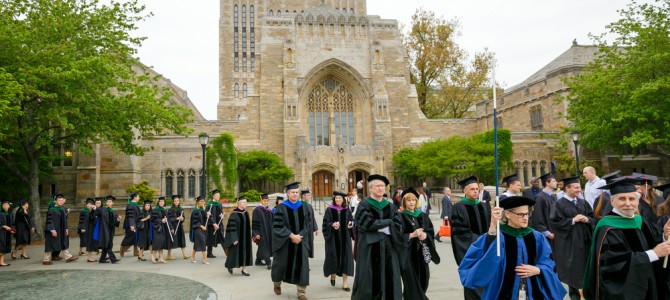
For those who went to college between 1950 and 1970, the fact that a religious university needs a religious leader goes without saying. But for students of later generations, like me, the mandate that a Christian, Jewish, or Muslim university requires a priest, rabbi, or imam to serve as its president is beginning to be questioned.
As ingrained religious presidents leave office, their replacements are increasingly lay people. Administratively, there is almost no difference between the capabilities of a lay person and an ordained person. They can both ensure that a university functions. But there is nonetheless a difference between the two. What qualities does a religious leader have that a lay person doesn’t? Why should religious institutions default to religious leaders when a lay person can perform the same duties just as well, if not better than, a religious leader?
When the first religiously affiliated universities were established, they tapped their own leadership to steer the institutions and fill teaching rolls. This went for Catholic and Protestant universities: the Pontifical Gregorian University in Rome was (and still largely is) staffed by Jesuits, and Harvard University in Boston was run by Congregationalists and Unitarians. Religious men were generally well-educated and could juggle a number of tasks.
Additionally, they had more resources, either from the church hierarchy or else pooled for their use from the congregation. There were capable lay people, too, just as there are today — a number of well-rounded statesmen come to mind — but the ordained religious were the only ones who filled the staff of religious institutions. Today, this default setting is more of suggestion than the way things actually run.
Religious Universities Have Distinct Missions
One of the biggest differences between secular universities (which have always been run by lay people, for obvious reasons) and religious ones is their missions. Take these two examples of mission and vision statements, one from Loyola University Chicago, representing religious schools, and the other from the University of Illinois, representing secular schools.
Loyola: “We are Chicago’s Jesuit, Catholic University-a diverse community seeking God in all things and working to expand knowledge in the service of humanity through learning, justice and faith.”
University of Illinois: “The University of Illinois is among the preeminent public universities of the nation and strives constantly to sustain and enhance its quality in teaching, research, public service and economic development.”
These statements are full of academic English but still present important distinctions. Loyola is rooted in the Catholic and Jesuit traditions, both of which contain massive amounts of knowledge in every discipline, and orients itself as a university toward certain principles (justice, faith) anchored in those traditions.
The University of Illinois, while still a renowned institution, has a different raison d’être. Whereas Loyola intends to further the principles of its faith through the university, the University of Illinois intends to produce research and further knowledge in a way that is very purposely detached from faith. Most public universities have a similar mission or vision statement.
Leaders Are Not Interchangeable
There is nothing wrong with this dichotomy per se, but the difference between the missions of secular and religious universities points towards a difference of leadership, and why one set of leaders works for one institution, secular or religious, but not both.
It would be out of the question to suggest that a priest, minister, or church elder (or rabbi or imam) serve as the president of, say, the University of Kansas. It should be equally odd to suggest that a business professional with a master’s degree in higher education administration — think E. Gordon Gee — should run The Catholic University of America (which, ironically, is run by such a professional).
With the dilution of American religion generally, and religion within higher education specifically, however, it is not surprising that religious universities are ceding ground to meet their secular counterparts. This decay has long been coming, and has a long way to go before it is whole, but the fact that lay leaders at religious schools aren’t second-guessed points to said decay, among all the other things I’ve observed.
Religious Leaders Express a Distinct Commitment
Perhaps the most important reason that religious institutions should retain their leadership is one of legitimacy. Catholic universities as well as Protestant ones tend to prominently display their faith traditions independent of whether they actually adhere to them. Nonetheless, the “Catholicity” or Protestant nature of a university is easy to pick out from the statements and practices the administration sets.
Mission and vision statements are obvious examples of this, but the religious nature of an institution can be observed everywhere from administration publications, the school website, crucifixes in the classrooms and, most importantly, the university’s curriculum. Perhaps a course or two (or three) of theology are required to graduate, as well as participation in a service program. This coursework is supposed to impart the faith tradition of the university and mold good graduates. On an institutional level, a university might also live out its values by advocating for the poor and disadvantaged, directly involving itself in the community, or some combination of that.
How odd, then, it would be for a lay leader to make those institutional commitments without the religious bona fides to do so. A lay leader can say the same things as a religious one, but there is something off about it. It is akin to seeing a doppelganger of someone we know: the person is both familiar and unknown. In this case, the words don’t match the messenger. When a religious leader speaks on his beliefs, he speaks with the authority of someone who has devoted his life to those beliefs, whereas a lay person — while capable — has other commitments and other devotions in life. One carries more weight than the other.
The importance of religious leaders at religious institutions comes down to the fact that they preserve, promote, and legitimize the mission of the institution in a way that a lay person can’t. For institutions that are dedicated to a certain set of beliefs, these factors go to the core of their existence. In the end, both leaders can say “Amen” — but only one has built his life around it.









